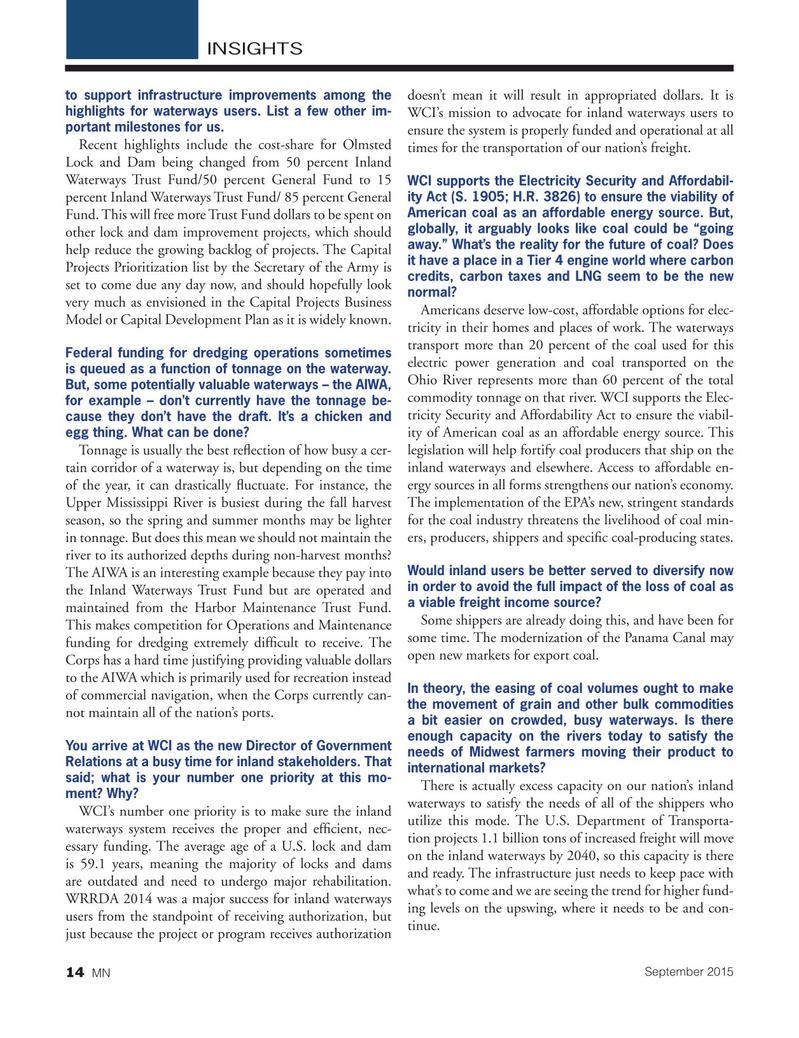
Page 14: of Marine News Magazine (September 2015)
Inland Waterways
Read this page in Pdf, Flash or Html5 edition of September 2015 Marine News Magazine
INSIGHTS doesn’t mean it will result in appropriated dollars. It is to support infrastructure improvements among the highlights for waterways users. List a few other im-
WCI’s mission to advocate for inland waterways users to portant milestones for us.
ensure the system is properly funded and operational at all
Recent highlights include the cost-share for Olmsted times for the transportation of our nation’s freight.
Lock and Dam being changed from 50 percent Inland
Waterways Trust Fund/50 percent General Fund to 15
WCI supports the Electricity Security and Affordabil- ity Act (S. 1905; H.R. 3826) to ensure the viability of percent Inland Waterways Trust Fund/ 85 percent General
American coal as an affordable energy source. But,
Fund. This will free more Trust Fund dollars to be spent on globally, it arguably looks like coal could be “going other lock and dam improvement projects, which should away.” What’s the reality for the future of coal? Does help reduce the growing backlog of projects. The Capital it have a place in a Tier 4 engine world where carbon
Projects Prioritization list by the Secretary of the Army is credits, carbon taxes and LNG seem to be the new set to come due any day now, and should hopefully look normal?
very much as envisioned in the Capital Projects Business
Americans deserve low-cost, affordable options for elec-
Model or Capital Development Plan as it is widely known. tricity in their homes and places of work. The waterways transport more than 20 percent of the coal used for this
Federal funding for dredging operations sometimes electric power generation and coal transported on the is queued as a function of tonnage on the waterway.
Ohio River represents more than 60 percent of the total
But, some potentially valuable waterways – the AIWA, commodity tonnage on that river. WCI supports the Elec- for example – don’t currently have the tonnage be- tricity Security and Affordability Act to ensure the viabil- cause they don’t have the draft. It’s a chicken and ity of American coal as an affordable energy source. This egg thing. What can be done?
Tonnage is usually the best re? ection of how busy a cer- legislation will help fortify coal producers that ship on the tain corridor of a waterway is, but depending on the time inland waterways and elsewhere. Access to affordable en- of the year, it can drastically ? uctuate. For instance, the ergy sources in all forms strengthens our nation’s economy.
Upper Mississippi River is busiest during the fall harvest The implementation of the EPA’s new, stringent standards season, so the spring and summer months may be lighter for the coal industry threatens the livelihood of coal min- in tonnage. But does this mean we should not maintain the ers, producers, shippers and speci? c coal-producing states. river to its authorized depths during non-harvest months?
Would inland users be better served to diversify now
The AIWA is an interesting example because they pay into in order to avoid the full impact of the loss of coal as the Inland Waterways Trust Fund but are operated and a viable freight income source?
maintained from the Harbor Maintenance Trust Fund.
Some shippers are already doing this, and have been for
This makes competition for Operations and Maintenance funding for dredging extremely dif? cult to receive. The some time. The modernization of the Panama Canal may
Corps has a hard time justifying providing valuable dollars open new markets for export coal. to the AIWA which is primarily used for recreation instead
In theory, the easing of coal volumes ought to make of commercial navigation, when the Corps currently can- the movement of grain and other bulk commodities not maintain all of the nation’s ports.
a bit easier on crowded, busy waterways. Is there enough capacity on the rivers today to satisfy the
You arrive at WCI as the new Director of Government needs of Midwest farmers moving their product to
Relations at a busy time for inland stakeholders. That international markets?
said; what is your number one priority at this mo-
There is actually excess capacity on our nation’s inland ment? Why?
WCI’s number one priority is to make sure the inland waterways to satisfy the needs of all of the shippers who utilize this mode. The U.S. Department of Transporta- waterways system receives the proper and ef? cient, nec- essary funding. The average age of a U.S. lock and dam tion projects 1.1 billion tons of increased freight will move is 59.1 years, meaning the majority of locks and dams on the inland waterways by 2040, so this capacity is there are outdated and need to undergo major rehabilitation. and ready. The infrastructure just needs to keep pace with
WRRDA 2014 was a major success for inland waterways what’s to come and we are seeing the trend for higher fund- users from the standpoint of receiving authorization, but ing levels on the upswing, where it needs to be and con- just because the project or program receives authorization tinue.
September 2015 14 MN

 13
13

 15
15
